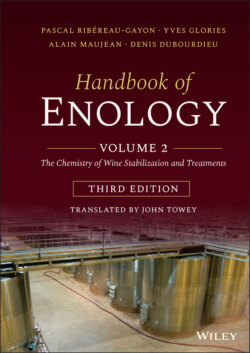Читать книгу Handbook of Enology, Volume 2 - Pascal Ribéreau-Gayon - Страница 65
Alkyl substituted hydrocarboxylic acid ethyl esters
ОглавлениеEthyl 2‐hydroxy‐4‐methylpentanoate adds a blackberry note to wine (Falcao et al., 2012). Its content is generally higher in red wines than in white wines of the same age (Lytra et al., 2012). In general, white wines contain only the R form, while red wines have both enantiomers at ratios that depend on age. The highest concentrations of the S isomer are found in the oldest wines. The average R/S ratio for ethyl 2‐hydroxy‐4‐methylpentanoate in red wines is 95/5 (m/m). The perception threshold of ethyl (2R)‐2‐hydroxy‐4‐methylpentanoate in a dilute alcohol solution is 126 μg/l or almost twice that of the S enantiomer (55 μl). This clearly shows that these thresholds are dependent on stereochemistry (Table 2.6). The perception threshold for the mixture of the two enantiomers (R/S, 95/5 m/m) is 51 μg/l in a dilute alcohol solution. The two enantiomers have similar aromas, reminiscent of blackberries. In red wines, the presence of these compounds leads to a general intensification of aroma as well as increased fresh black fruit notes.
TABLE 2.6 Main Substituted Esters and Their Impact on Red Wines
| Compounds | Descriptors | Average content in red wines (μg/l) | Perception threshold in dilute alcohol solution (μg/l) | Sensory impact |
|---|---|---|---|---|
| 2‐Methylbutyl (2S)‐acetate | Banana | 70 | 313 | Enhancer of black fruit, fresh fruit, and jammy aromas |
| Ethyl (2S)‐2‐methylbutanoate | Green apple(Granny Smith), strawberry | 50 | 1.53 | Enhancer of black fruit aromas |
| Ethyl (2R)‐2‐hydroxy‐4‐methylpentanoate | Blackberry | 400 | 126 | Enhancer of black fruit and fresh fruit aromas |
| Ethyl (2S)‐2‐hydroxy‐4‐methylpentanoate | Blackberry | 20 | 55 | |
| Ethyl (3R)‐3‐hydroxybutanoate | Fruity, butyric (cheese) | 80 | 63,000 | Enhancer of black fruit and fresh fruit aromas |
| Ethyl (3S)‐3‐hydroxybutanoate | Solvent andalcohol | 350 | 21,000 |
Ethyl 2‐hydroxy‐3‐methylbutanoate, whose content increases during bottle aging, is present at the end of alcoholic fermentation in the R form only. The S enantiomer only appears later on (Gammacurta et al., 2015; Lytra et al., 2017).
